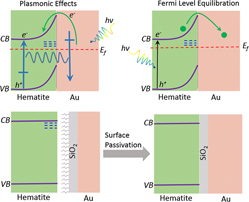Crossref Citations
This article has been cited by the following publications. This list is generated based on data provided by
Crossref.
Ye, Wei
Long, Ran
Huang, Hao
and
Xiong, Yujie
2017.
Plasmonic nanostructures in solar energy conversion.
Journal of Materials Chemistry C,
Vol. 5,
Issue. 5,
p.
1008.
Wu, Nianqiang
2018.
Plasmonic metal–semiconductor photocatalysts and photoelectrochemical cells: a review.
Nanoscale,
Vol. 10,
Issue. 6,
p.
2679.
Joseita dos Santos Costa, Maria
dos Santos Costa, Gilson
Estefany Brandão Lima, Aline
Eduardo da Luz Júnior, Geraldo
Longo, Elson
Santos Cavalcante, Laécio
and
da Silva Santos, Reginaldo
2018.
Photocurrent Response and Progesterone Degradation by Employing WO3 Films Modified with Platinum and Silver Nanoparticles.
ChemPlusChem,
Vol. 83,
Issue. 12,
p.
1153.
Eftekharinia, Behrooz
Moshaii, Ahmad
Sobhkhiz Vayghan, Nader
and
Dabirian, Ali
2018.
Efficient Nanoporous Hematite Photoanodes Prepared by Electron Beam Evaporation and Au Modification.
ChemCatChem,
Vol. 10,
Issue. 20,
p.
4665.
Li, Jiangtian
Griep, Mark
Choi, YuSong
and
Chu, Deryn
2018.
Photoelectrochemical overall water splitting with textured CuBi2O4as a photocathode.
Chemical Communications,
Vol. 54,
Issue. 27,
p.
3331.
Li, Jiangtian
and
Chu, Deryn
2018.
Multifunctional Photocatalytic Materials for Energy.
p.
49.
Cerkez, Elizabeth B.
Dutton, Kaitlyn G.
Ghidey, Yonatan G.
Kukulka, Mark A.
Valentine, Ann M.
and
Strongin, Daniel R.
2019.
Photochemistry of ferritin decorated with plasmonic gold nanoparticles.
Environmental Science: Nano,
Vol. 6,
Issue. 1,
p.
85.
Hankin, Anna
Bedoya-Lora, Franky E.
Alexander, John C.
Regoutz, Anna
and
Kelsall, Geoff H.
2019.
Flat band potential determination: avoiding the pitfalls.
Journal of Materials Chemistry A,
Vol. 7,
Issue. 45,
p.
26162.
Ma, Yanxiao
Shinde, Pravin S.
Li, Xiao
and
Pan, Shanlin
2019.
High-Throughput Screening and Surface Interrogation Studies of Au-Modified Hematite Photoanodes by Scanning Electrochemical Microscopy for Solar Water Splitting.
ACS Omega,
Vol. 4,
Issue. 17,
p.
17257.
Wang, Zhiqiang
Wei, Yankuan
Wang, Xinyi
Zhang, Wenshuai
and
Su, Jinzhan
2019.
Plasmonic Au Nanopraticles Modified Nanopyramid-Arrays BiVO4with Enhanced Photoelectrochemical Activity.
Journal of The Electrochemical Society,
Vol. 166,
Issue. 5,
p.
H3138.
Huang, Hung Ji
Wu, Jeffrey Chi-Sheng
Chiang, Hai-Pang
Chou Chau, Yuan-Fong
Lin, Yung-Sheng
Wang, Yen Han
and
Chen, Po-Jui
2019.
Review of Experimental Setups for Plasmonic Photocatalytic Reactions.
Catalysts,
Vol. 10,
Issue. 1,
p.
46.
Saha, Sudip
Victorious, Amanda
Pandey, Richa
Clifford, Amanda
Zhitomirsky, Igor
and
Soleymani, Leyla
2020.
Differential Photoelectrochemical Biosensing Using DNA Nanospacers to Modulate Electron Transfer between Metal and Semiconductor Nanoparticles.
ACS Applied Materials & Interfaces,
Vol. 12,
Issue. 33,
p.
36895.
Tang, Haibin
Chen, Chih-Jung
Huang, Zhulin
Bright, Joeseph
Meng, Guowen
Liu, Ru-Shi
and
Wu, Nianqiang
2020.
Plasmonic hot electrons for sensing, photodetection, and solar energy applications: A perspective.
The Journal of Chemical Physics,
Vol. 152,
Issue. 22,
Amourizi, Fereshteh
Dashtian, Kheibar
and
Ghaedi, Mehrorang
2020.
Electrostatically controlled plasmonic effects of gold nanoparticles with indigo-carmine functionation for rapid and straightforward colorimetric detection of Cu2+ ions.
Spectrochimica Acta Part A: Molecular and Biomolecular Spectroscopy,
Vol. 230,
Issue. ,
p.
118026.
Tofanello, Aryane
Freitas, Andre L. M.
Carvalho, Waldemir M.
Salminen, Turkka
Niemi, Tapio
and
Souza, Flavio L.
2020.
Hematite Surface Modification toward Efficient Sunlight-Driven Water Splitting Activity: The Role of Gold Nanoparticle Addition.
The Journal of Physical Chemistry C,
Vol. 124,
Issue. 11,
p.
6171.
Tofanello, A.
Diao, Z.
Djatoubai, E.
Su, J. Z.
Shen, S. H.
Souza, F. L.
and
Vayssieres, L.
2020.
Engineering hematite/plasmonic nanoparticle interfaces for efficient photoelectrochemical water splitting.
Journal of Applied Physics,
Vol. 128,
Issue. 6,
Li, Jiangtian
and
Chu, Deryn
2020.
Dual Roles of MoO3 Thin Film in Improving the Performance of Copper Bismuth Oxide Photocathode for Solar Water Splitting.
Journal of Electrochemical Energy Conversion and Storage,
Vol. 17,
Issue. 4,
Victorious, Amanda
Saha, Sudip
Pandey, Richa
and
Soleymani, Leyla
2021.
Enhancing the Sensitivity of Photoelectrochemical DNA Biosensing Using Plasmonic DNA Barcodes and Differential Signal Readout.
Angewandte Chemie International Edition,
Vol. 60,
Issue. 13,
p.
7316.
Santangelo, Saveria
Raza, Muhammad Hamid
Pinna, Nicola
and
Patanè, Salvatore
2021.
On the plasmon-assisted detection of a 1585 cm−1 mode in the 532 nm Raman spectra of crystalline α-Fe2O3/polycrystalline NiO core/shell nanofibers.
Applied Physics Letters,
Vol. 118,
Issue. 25,
Czelej, Kamil
Colmenares, Juan Carlos
Jabłczyńska, Katarzyna
Ćwieka, Karol
Werner, Łukasz
and
Gradoń, Leon
2021.
Sustainable hydrogen production by plasmonic thermophotocatalysis.
Catalysis Today,
Vol. 380,
Issue. ,
p.
156.
